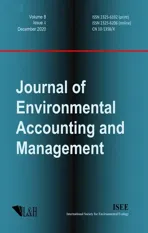Green Lifestyle among Indonesian Millennials: A Comparative Study between Asia and Europe
2021-01-19GenovevaGenovevaJhanghizSyahrivar
Genoveva GenovevaJhanghiz Syahrivar
1 School of Business,President University,Jl. Ki Hajar Dewantara,Bekasi 17550,Indonesia
2 Institute of Marketing,Corvinus University of Budapest,F¨ov´am t´er 8,Budapest 1093,Hungary
Keywords New Environmental Paradigm Religious Passion Spirituality Green Behavior Intention
Abstract Unethical business practices coupled with irresponsible consumption activities come with painful environmental costs. Fortunately,various studies have indicated that ecological concerns are the highest among the millennial generation. The aim of this research is to investigate the factors influencing green lifestyle among Indonesian millennials who live in Asia and Europe. Cultural elements, such as religious passion and spirituality, are also incorporated in this study in order to understand how they influence green intention and lifestyle. To our best knowledge, this is the first comparative study to understand the green lifestyle of Indonesian millennials in the two regions. This study gathered a total of 204 valid respondents. We employed a Structural Equation Modelling method to test our hypotheses.We found that 1)the New Environmental Paradigm is a predictor of green behavior intention 2)religious passion, spirituality and green behavior intention are predictors of green lifestyle. Theoretical contributions as well as managerial implications are offered in this study.
1 Introduction
The world needs a balance between the pursuit of competitive economics versus environmental protection and preservation. Competitive economics has provided beneficial goods and services for people’s comforts; but unfortunately it also comes with some painful environmental costs (Tencati and Zsolnai, 2010; Taygashinova and Akhmetova, 2019; Keszey, 2020). Therefore, every citizen has the moral responsibility to always favor products and lifestyles that are environmentally friendly before the damage done on earth reaches an irrevocable point(Asghar et al.,2019;Droz,2020).
Among the countries that struggle with environmental issues is Indonesia (Meilasari-Sugiana, Sari and Anggraini, 2018; Rachmatullah, Lee and Ha, 2020). As the only representative from Southeast Asia in the G20,the country is retching up its infrastructure to support its various industries and increase direct investment inflows. Unfortunately,the rapid development all over the country comes at the expense of the natural environment(Kurniawan and Managi, 2018). Although there is an increasing popularity of green-based products and services in Indonesia, green lifestyle has not been strongly embedded in the Indonesian way of life(Chairy et al., 2019; Alamsyah, Othman and Mohammed, 2020; Suharti and Sugiarto, 2020). Their studies called for an integration of green lifestyle into the short-term and long-term strategies of Indonesian companies,organizations and government.
This research aims to investigate factors influencing the green lifestyle among Indonesian millennials who live in Asia and Europe. Based on the data released by the Ministry of Women Empowerment and Child Protection(MoWECP)of the Republic of Indonesia in 2018, 34 percent of Indonesian population are categorized as millennials(1980-2000). According to the Ministry, they represent a demographic dividend in 2020 hence we argue that understanding their green behaviors within and outside the country are of paramount importance.Due to the increasing ecological catastrophes in the recent years,more and more millennials express their interests towards environmental protection and preservation activities(Veiga et al.,2017;Johnson and Chattaraman,2020).Nevertheless, to what extent their concerns towards the environment translate into the green lifestyle has not been explored in the previous studies. Green lifestyle in this study is not limited to green consumption but also participation in green events. Indeed, previous studies have suggested that high environmental concerns often failed to manifest as a solid behavior that favors the environment,such as higher preference for green products over conventional ones (Joshi and Rahman, 2015; Nguyen, Nguyen and Hoang, 2019; Nosi et al., 2020). In this study, we assumed that Indonesian millennials who live in Asia and Europe might differ in their propensity towards the green lifestyle. To our best knowledge, this is the first comparative study between Indonesian millennials in Asia and Europe. Moreover,Indonesian millennials as green consumers are underrepresented in green consumption literature.
Previous studies suggest that many companies in Indonesia are in the race to develop green products and present themselves as“green company”in hope to appeal to environmentally-conscious citizens(Maclean,Jagannathan and Panth, 2018; Chariri et al., 2019; Chairy et al., 2019). To improve their competitiveness, local businesses may also combine the green concept with Halal(permissible)concept in order to appeal to Muslim majority in the country (Ali, Halim and Ahmad, 2016; Kurniawati and Savitri, 2019; Chairy and Syahrivar,2019;Ainin et al.,2020). A study by Golnaz et al. (2010)suggests that consumers’concerns on environmental issues is one of the predictors of purchase intention of Halal products. Similarly,a study by Ariffin,Dihanan and Wahid(2019)suggest that Halal products are more preferred by consumers when they are perceived to be safe,organic and environmentally friendly. This trend is in line with the previous studies which suggest that national culture as well as religious values might play important roles in green attitude and behavior(De Klerk,Kearns and Redwood, 2019; Halder et al., 2020). Therefore, in this study we also incorporated religious passion and spirituality–the two less investigated factors–into our model.
This study is organized as follows: First is the literature review where we presented the core theories concerning each variable presented in the model. Second is the research methodology where we elaborated research steps taken in this study. Third is the findings where we presented the results of the analysis. Fourth is the discussions where we discussed our findings,theoretical contributions,managerial implications and future research directions. Fifth is the conclusion where we presented the summary of this study.
2 Literature review
New Environmental Paradigm
The term and the measurement for New Environmental Paradigm(NEP)was developed by Dunlap and Van Liere(1978). NEP represents an environmental concern and attitude,particularly about the capacity of mankind to disturb nature’s equilibrium,the limits to human societies’development,and the right of mankind to rule over the rest of nature(Dunlap et al., 2000). The original 12 items of NEP measurement in 1978 which are widely used have received various critics and undergone several revisions(Dunlap,2008).
Some notable challenges present when NEP is used across countries, cultures or specific religious groups.For instance, Gr´uˇnov´a et al. (2019) applied NEP measurement to students in Senegal to analyze their environmental attitude. They noted a low internal consistency of the scale for the investigated population which they attributed to “strong religious beliefs, different understandings of the place of humankind in nature, and weak awareness of humans’ impact on the natural world.” Moreover, a meta-analysis of NEP usage over the last 30 years by Hawcroft and Milfont(2010)reveals significant variations in the way the NEP scale was used by previous researchers. Some of these variations include differences in the numbers of items and scales used.Therefore, more studies are required to accurately assess the effectiveness of NEP across religious groups and cultures.
Green Behavior Intention
Behavior intention is defined as the probability that someone will commit a given behavior(Bhaduri,2020).In this study, green behavior intention (GBI) refers to how much effort an individual is willing to make in order to preserve his or her natural environment. Among the indicators of GBI are the intention to engage in environmentally friendly behavior,the intention to stop wasting natural resources,and the intention to put one’s waste(e.g. organic vs non-organic)in the right trash bin(Mancha and Yoder,2015).
Previous studies suggest that NEP has a significant role in green behavior intention. For instance,a study by Luo and Deng(2008)involving 438 respondents in China reveals that NEP is a significant predictor of naturebased tourism. Similarly, in the context of Spain, a study by Hartmann and Apaolaza-Ib´a~nez (2012) reveals that NEP has a positive effect towards the intention to purchase green energy brands. Finally,a study by Shukla(2019)among Indian millennials affirms the positive and significant relationship between environmental concern(e.g. NEP) on green purchase intention. We argue that Indonesian millennials who have high environmental concerns also have high intentions on green consumption. Therefore,the hypothesis is formulated as follows:
H1: New Environmental Paradigm has a positive influence on Green Behavior Intention.
Green Lifestyle
A green lifestyle involves eco-friendly consumptions and habits(Florenthal and Arling,2011).According to Lorenzen(2012),green lifestyle is a pattern of living that involves careful considerations on the adverse impacts of one’s daily activities towards the environment and a meaningful narrative that guides the process. Green lifestyle in this study goes beyond the purchase of green products but also includes one’s active involvement in green events.
The relationship between green intention and behavior is somewhat inconclusive. In line with the Theory of Planned Behavior (TPB) by Ajzen (1991), green intention is assumed to predict green behavior, such as green purchase (Yuriev et al., 2020). It means that the higher the green (purchase) intention, the higher the(manifested) green behavior. However, previous studies in green consumption also note some inconsistencies between intention and behavior(Joshi and Rahman,2015;Nguyen,Nguyen and Hoang,2019;Nosi et al.,2020).For instance,a study by Echegaray and Hansstein(2017)in Brazil suggests that although majority respondents had a positive intention towards recycling electronic appliances, only a few of them actually adopted the ewaste recycling practices. They argued that a socially acceptable view towards recycling might explain the high intention. Similarly, in the context of Vietnam, Nguyen et al. (2019) argued that the intention-behavior gap exists due to green product availability (scarcity) and the belief whether consumers could make a difference to their environment by purchasing green products. Nevertheless, they found that green purchase intention had a positive effect on green behavior. In this study, we argue that Indonesian millennials who have high green behavior intentions are more inclined towards green lifestyle. Therefore,we formulated our hypothesis as follows:
H2: Green Behavior Intention has a positive influence on Green Lifestyle
According to Dunlap and Van Liere(1978),NEP is an environmental attitude. In line with the Knowledge-Attitude-Behavior(KAB)Model,previous studies suggest that environmental attitude has a direct relationship with green behavior(Gregory-Smith,Manika and Demirel,2017;Ito and Kawazoe,2019;Siyavooshi,Foroozanfar and Sharifi,2019;Liu,Teng and Han,2020).For instance,a study by Liu,Teng and Han(2020)with Chinese samples affirmed a positive and significant relationship between environmental attitude and pro-environmental behavior. In the organizational context,Hameed et al. (2020)found that NEP positively and significantly influenced organizational citizenship behavior toward the environment. In this study,we argue that millennials who are high in NEP are more prone to adopt a green lifestyle. Therefore,we formulated our hypothesis as follows:
H3: New Environmental Paradigm has a positive influence on Green Lifestyle
Religious Passion
Religiosity is defined as the commitment towards religious practices as well as the importance of religion to one’s life (Kim et al., 2020). According to Huber and Huber (2012), there are 5 dimensions of religiosity:intellectual dimension, ideology, public practice, private practice and religious experience. Religious Passion in this study is defined as one’s strong and positive feelings and attachment towards religion as manifested in his/her preoccupying thoughts about religious issues as well as his/her willingness to learn more about his/her religion,to participate in religious services and to be connected to a religious community.
Religion remains a relevant and significant cultural element in the modern era. It represents the large and universal social institutions with a powerful influence on the attitudes, values and behaviors of believers (Engelland, 2014; Rodriguez-Rad and Ramos-Hidalgo, 2018). However, there is little attention about the role of religion in socially responsible consumption behavior(Engelland,2014;Graafland,2017).
Existing studies about the relationship of religion and socially responsible consumption are inconclusive. In the US context, Davari, Iyer and Strutton (2017) concluded that religiosity was a significant predictor of consumers’intentions to purchase green products. In the context of China,Wang et al. (2020)found that intrinsic religiosity positively and significantly influenced pro-environmental behavioral intention. Meanwhile, in the context of the Netherlands, Graafland(2017)concluded that religiosity had no direct effect on the demand for socially responsible products. Moreover, previous studies gave no clear understanding about how religiosity creates socially responsible behavior. In this study,we argue that Indonesian millennials who are strongly passionate about their religions have high intention on green consumption. Therefore,the hypothesis is formulated as follows:
H4: Religious Passion has a positive influence on Green Behavior Intention.
Spirituality
Other terminology that is often related to religiosity is spirituality. Spirituality is defined as “one’s sense of purpose, meaning, beliefs, expression of virtue and practices that connect with the transcendent” (Mata-McMahon,Haslip and Schein,2020). Kidwai et al. (2014)argue that people who are deeply religious are also spiritual. However,previous studies suggest that not all spiritual people are religious,suggesting that religiosity and spirituality are two distinct constructs(Harvey,2016;Da Costa,2020).
Previous studies suggest that spirituality has a positive influence on consumers’ intentions towards green purchases. For instance,a study by Joshi(2017)with Indian samples reveals that spirituality has a positive and significant relationship with green purchase intention. Similarly,a study by Rodriguez-Rad and Ramos-Hidalgo(2018) with Spanish samples affirmed the positive effect of spirituality on the intention to purchase products made of recycled materials and products from companies with a strong record of protecting the environment.In this study, we argue that Indonesian millennials who are high in spirituality have high intention on green consumption. Therefore,the hypothesis is formulated as follows:
H5: Spirituality has a positive influence on Green Behavior Intention.
Previous studies have highlighted the role of beliefs (e.g. religious beliefs) in pro-environmental behavior(Arli and Tjiptono, 2017; Muhamad, Syihab and Achour, 2019; Taylor, Wright and LeVasseur, 2020). The term religious environmentalism refers to the idea that environmental protection and preservation are parts of human sacred duties on earth (Lorenzen, 2012). Many sacred texts (e.g. Quran, Bible) place significance on the protection and preservation of the natural environment (Arli and Tjiptono, 2017; Muhamad et al., 2019)hence we see that adopting a green lifestyle goes harmoniously with one’s belief. In this study, we argue that Indonesian millennials who are strongly passionate about their religions are more inclined towards green lifestyle. Therefore,we formulated our hypotheses as follows:
H6: Religious Passion has a positive influence on Green Lifestyle
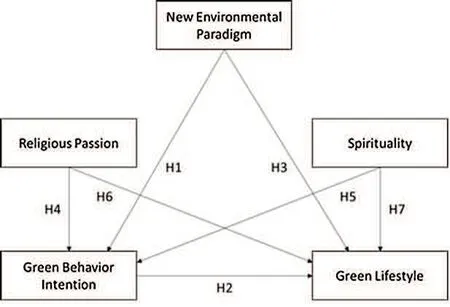
Fig.1 Theoretical framework.
Previous studies suggest that spirituality is connected to green lifestyle. For instance, a study by Joshi and Rahman (2015) among young employees in India reveals a positive relationship between spirituality and sustainable purchase behavior. In the context of Pakistan, Saleem et al. (2018) highlight the role of spirituality on eco-socially conscious consumer behavior. Moreover, a comparative study by Werner, Spiller and Meyerding(2020)with Indian and American samples suggests that spirituality has a positive relationship with pro-environmental behavior. We argue that Indonesian millennials who are high in spirituality are more inclined towards green lifestyle. Therefore,we formulated our hypotheses as follows:
H7: Spirituality has a positive influence on Green Lifestyle
3 Research methods
Fig. 1 illustrates the theoretical framework of this study. A total of five variables will be incorporated in this research, namely New Environmental Paradigm, Religious Passion, Spirituality, Green Behavior Intention and Green Lifestyle. In total there are seven hypotheses being tested in this study.
The population of this research are Indonesian millennial green consumers who live in Asia and Europe.This study employed purposive sampling. Respondents had to declare that they consumed green products. We spread an online questionnaire(5-likert scale)to our personal networks and referrals(snowball sampling). This study managed to gather 204 valid respondents. The detail is presented in Table 1:
The online questionnaire had two parts: respondent profile and the main part consisting of four different measurements. The measure for New Environmental Paradigm was adopted from the work of Dunlap et al.(2000); the measure for Religiosity was adopted from the work of Huber and Huber (2012); the measure for Green Behavior Intention was adopted from the work of Mancha and Yoder (2015); finally, the measure for Green Lifestyle was adopted from the work of Florenthal and Arling(2011). The retained items can be seen in Table 2:
This study employed Structural Equation Modelling (SEM) method via AMOS Software. We used the work of Schreiber et al. (2006) as the primary guideline for conducting SEM analysis. First, we conducted Exploratory Factor Analysis(EFA)in order to test whether each item belongs to the construct(factor)it intends to measure. We examined several aspects in this phase, among others: the KMO(Kaiser-Meyer-Olkin)index,the Eigenvalues and total variance explained, and the factor loadings. Second, we conducted Confirmatory Factor Analysis(CFA)in order to test the hypotheses and the model fitness. We examined several fit indices in this phase,among others: The Root Mean Square Error of Approximation(RMSEA),Standardized Root Mean Square Residual (SRMR), Goodness of Fit Index (GFI), Adjusted Goodness of Fit Index (AGFI), Normed-Fit Index (NFI), Tucker Lewis index (TFI) and Comparative Fit Index (CFI). Lastly, we refined our model by removing variables with statistically non-significant relationships and presented an alternative(trimmed)model as suggested by Hays(1989).
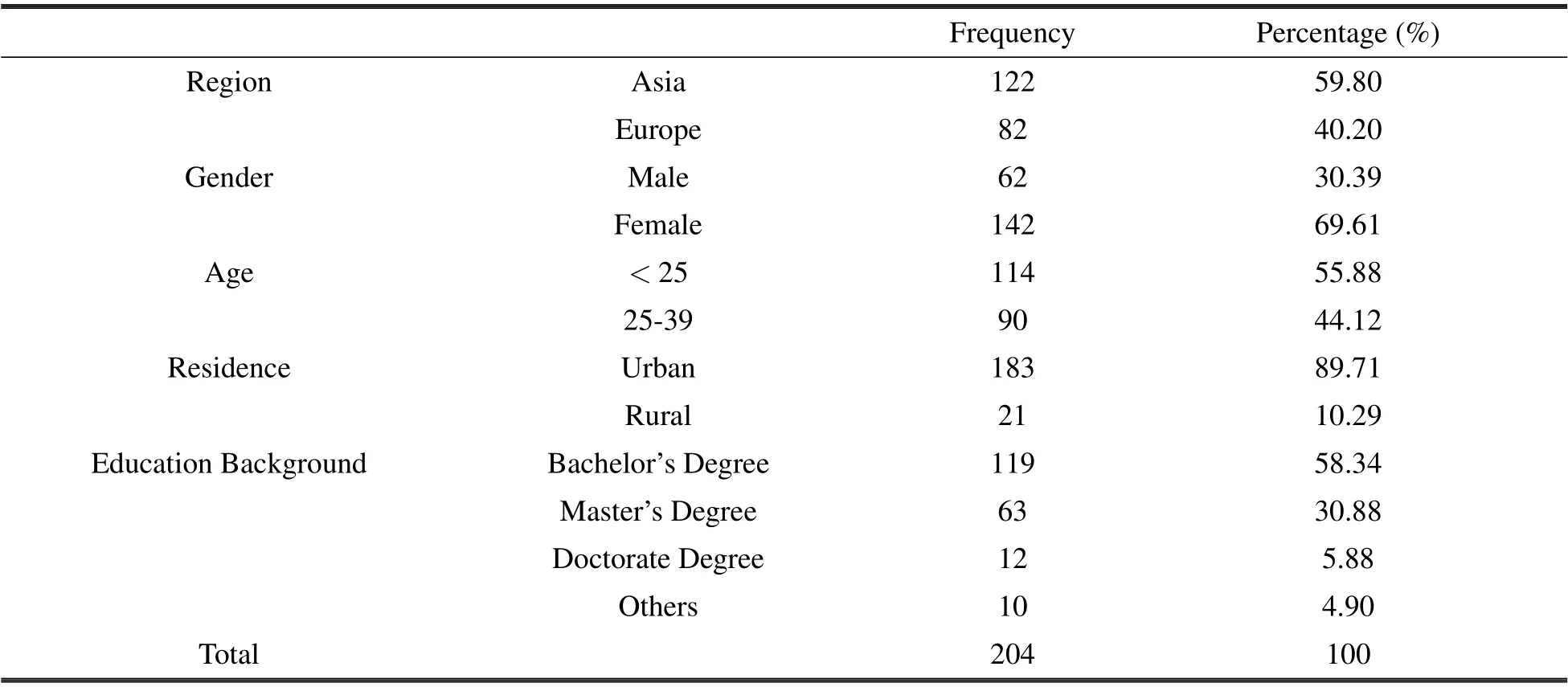
Table 1 Respondent profile.
4 Findings
4.1 Descriptive analysis(Regions Comparison)
Descriptive statistics are presented in Table 3,4,5,6 and 7.The Mean values suggest that Indonesian millennials in Asia are slightly higher in terms of New Environmental Paradigm(NEP),Religious Passion(PSN),Spirituality (SPR), Green Behavior Intention (GBI) and Green Lifestyle (GLS) compare with Indonesian millennials in Europe. Since the samples between Asia and Europe are not equal,we have three concerns here: 1)whether the Mean values between the two regions were statistically different which we confirmed through Levene’s Test 2) whether the unequal sample sizes affected the results which we confirmed through Brown-Forsythe robust test 3) whether the results were due to the regions where they lived which we confirmed through Chi-Square analysis.
Levene’s Test is used to test whether the Mean values between two regions (Asia versus Europe) are statistically different. The results suggest that we have sufficient evidence to conclude that the Mean values of NEP(Sig. 0.035<0.05),PSN(Sig. 0.004<0.05),SPR(Sig. 0.00<0.05)and GLS(Sig. 0.038<0.05)are statistically different.
Brown-Forsythe test is used when samples are small and unequal. Unlike Levene’s,Brown-Forsythe test is claimed to be more robust(Brown and Forsythe,1974;Parra-Frutos,2013). Through this test,we wish to know if the differences in Mean values between the two groups are due to differences in sample sizes. The results suggest that GLS1 (Sig. 0.018), GLS2 (Sig. 0.019), PSN1 (Sig. 0.19), PSN3 (Sig. 0.00), PSN4 (Sig. 0.00),SPR1(Sig. 0.001),SPR2(Sig. 0.006),SPR3(Sig. 0.012)and SPR4(Sig. 0.036)reject the null hypothesis(Sig.<0.05)that the differences in Mean values between the two groups(Asia vs Europe)are due to differences in sample sizes.
The Chi-Square test is used to test whether there is a relationship between two categorical variables. The results suggest that there are positive and significant relationships (sig.<0.05) between Regions (Asia vs Europe)on PSN1(Sig. 0.024),PSN3(Sig. 0.001),PSN4(Sig. 0.000),SPR1(Sig. 0.005),SPR2(Sig. 0.034),SPR3(Sig. 0.008),SPR4(Sig. 0.047),GLS1(Sig. 0.026)and GLS2(Sig. 0.040).
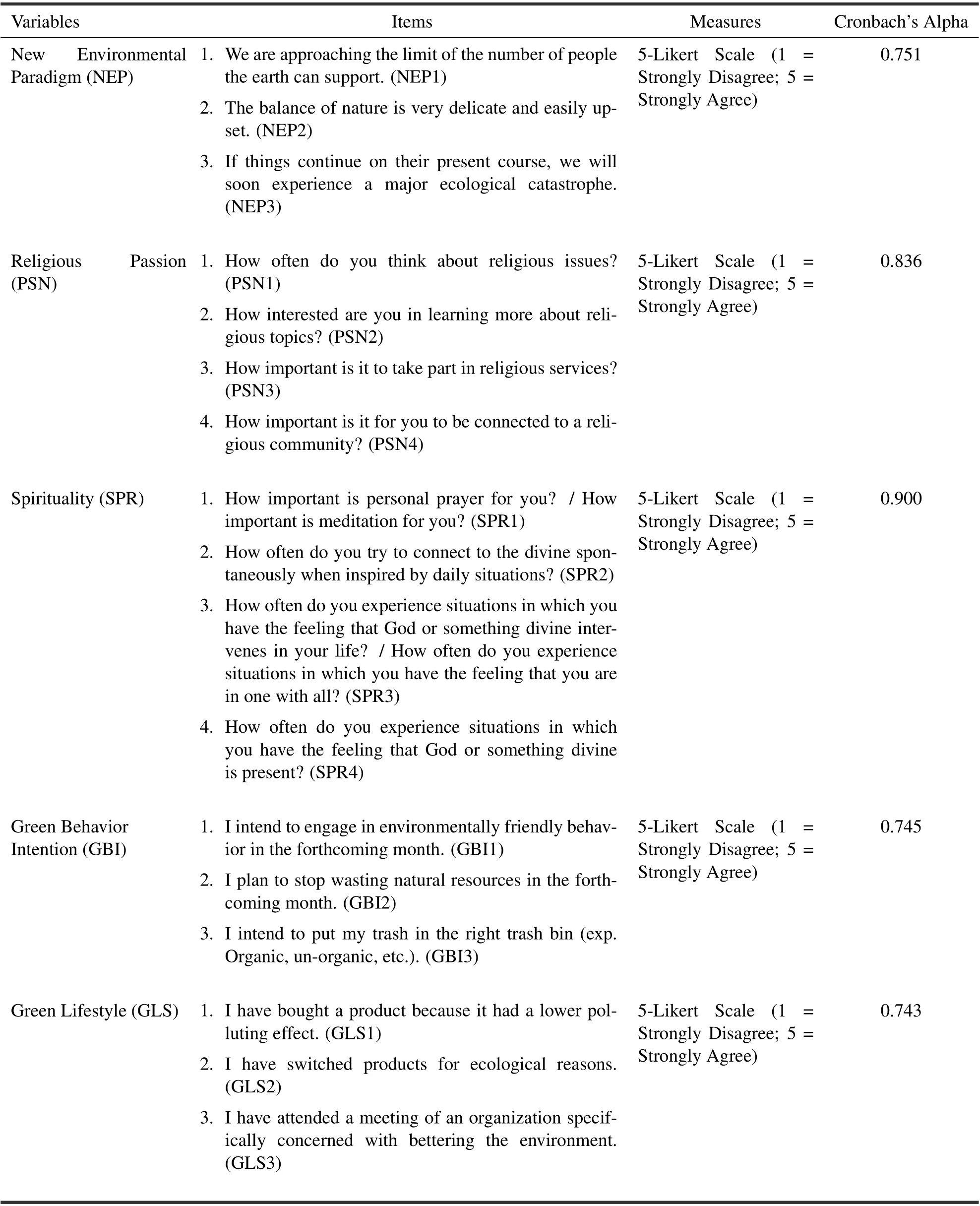
Table 2 Measures and reliability.

Table 3 New environmental paradigm(NEP).
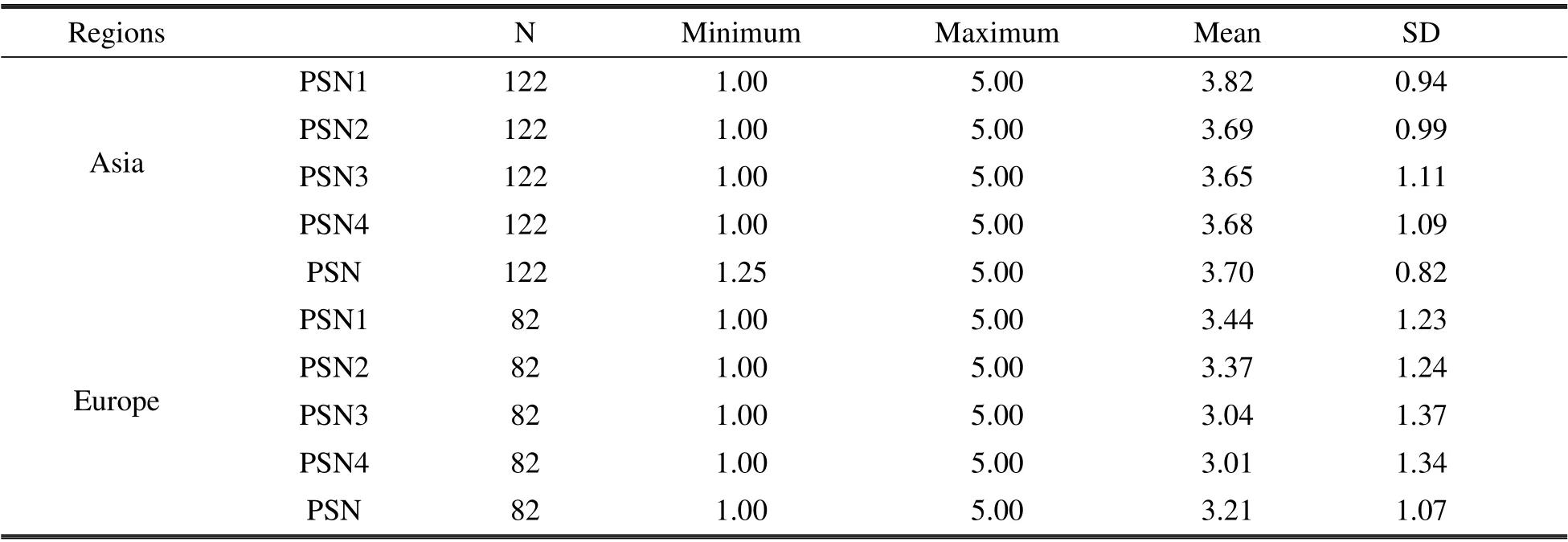
Table 4 Religious passion(PSN).
The Chi-Square test indicates that there is no relationship between Regions (Asia vs Europe) and NEP.Nevertheless, the descriptive statistics of NEP between the two regions is presented in Table 3. The Standard Deviation(SD)values are less than 1 which indicates that the value of each case is close to the Mean value.
The Chi-Square test indicates that there is a relationship between Regions(Asia vs Europe)and PSN.The descriptive statistics of PSN between the two regions is presented in Table 4. Indonesians who live in Asia think more about religious issues (PSN1), place more importance on taking part in religious services (PSN3) and place more importance on connecting to a religious community(PSN4)compared with Indonesian millennials in Europe. In general, Indonesian millennials who live in Asia are higher in PSN compared with Indonesian millennials in Europe. The SD values are mostly greater than 1 which indicates that the value of each case is far from the Mean value.
The Chi-Square test indicates that there is a relationship between Regions(Asia vs Europe)and SPR.The descriptive statistics of SPR between the two regions is presented in Table 5.Indonesian millennials in Asia place more importance on personal prayer or meditation(SPR1),try more often to connect to the divine spontaneously when inspired by daily situations(SPR2),experience more situations in which they have the feeling that God or something divine intervenes in your life or that they are in one with all(SPR3)and experience more situations in which they have the feeling that God or something divine is present(SPR4)compare with Indonesian millennials in Europe. In general,Indonesian millennials in Asia are higher in SPR compared with Indonesian millennials in Europe. For Asia Region,the SD values are less than 1 which indicates that the value of each case is close to the Mean value. Meanwhile,the SD values of SPR of Indonesian millennials in Europe are greater than 1 which indicates that the value of each case is far from the Mean value.

Table 5 Spirituality(SPR).

Table 6 Green behavior intention(GBI).

Table 7 Green lifestyle.
The Chi-Square test indicates that there is no relationship between Regions (Asia vs Europe) and GBI.Nevertheless,the descriptive statistics of GBI between the two regions is presented in Table 6. The SD values are mostly less than 1 which indicates that the value of each case is close to the Mean value.
The Chi-Square test indicates that there is a relationship between Regions(Asia vs Europe)and GLS.The descriptive statistics of GLS between the two regions is presented in Table 7. Indonesian millennials in Asia are more committed to buy products that have a lower polluting effect(GLS1)and to switch products for ecological reasons (GLS2) compared with Indonesian millennials in Europe. The SD values are mostly greater than 1 which indicates that the value of each case is far from the Mean value.

Table 8 KMO and Bartlett’s test

Table 9 Total variance explained.
4.2 Factor analysis
The KMO (Kaiser-Meyer-Olkin) index ranges from 0 to 1, with 0.50 considered suitable for factor analysis(Kaiser, 1970). Based on Table 8, the KMO is 0.812 which indicates that the samples are adequate for factor analysis.
The adequacy of the five factors produced during EFA will be measured against two criteria: first, the cumulative variance explained should exceed 60 percent and the Eigenvalues should be greater than 1(Nunayon,Olanipekun and Famakin,2020). Based on Table 9,the five factors explained 71.493 percent(>60%)variance with Eigenvalues are 2.010(>1).
Scarcely have the violets come forth12, but there on the rampart,just opposite the beautiful Castle of Rosenberg, there is a treebright with the first green buds. Every year this tree sends forthfresh green shoots. Alas13! It is not so with the human heart! Darkmists, more in number than those that cover the northern skies,cloud the human heart. Poor child! thy friend s bridal chamber14 is ablack coffin15, and thou becomest an old maid. From the almshousewindow, behind the balsams, thou shalt look on the merry children atplay, and shalt see thine own history renewed.
At least two or three items must load on a factor so it can be given a meaningful interpretation (Russell,2002). The factor loading per item should be more than 0.6(Abou-Youssef et al.,2011). Based on Table 10,our construct validity satisfies all the necessary requirements.
The Average Variance Extracted(AVE)for each factor should be higher than 0.5(Huang et al.,2013). The AVE of each factor is as follows: NEP is 0.64, Religious Passion is 0.57, Spirituality is 0.70, Green Behavior Intention is 0.58 and Green Lifestyle is 0.61. Therefore,we conclude that each factor is sufficiently explained and that we can proceed to SEM.
4.3 SEM model
We present the SEM Model in Fig. 2. The Squared Multiple Correlation of Green Lifestyle is 42.5 percent. It means that the predictors of Green Lifestyle explain 42.5 percent of its variance.
Based on Table 11,New Environmental Paradigm has a positive relationship with Green Behavior Intention at statistically 0.01 significance. Green Behavior Intention has a positive relationship with Green Lifestyle at statistically 0.01 significance. Religious Passion has a positive relationship with Green Lifestyle at 0.05 significance. Lastly,Spirituality has a negative relationship with Green Lifestyle at 0.05 significance.
Schreiber et al. (2006) recommend the following threshold in Table 12 for assessing goodness of fit of a model. It can be concluded that the model has a moderate fit.
4.4 Trimmed model
We present the trimmed model in Fig. 3. Trimmed model is achieved by removing non-significant effects in order to see if the alternate model could generate a better model fit (Hays, 1989). The Squared MultipleCorrelation(SMC)of Green Lifestyle is 37.1 percent.
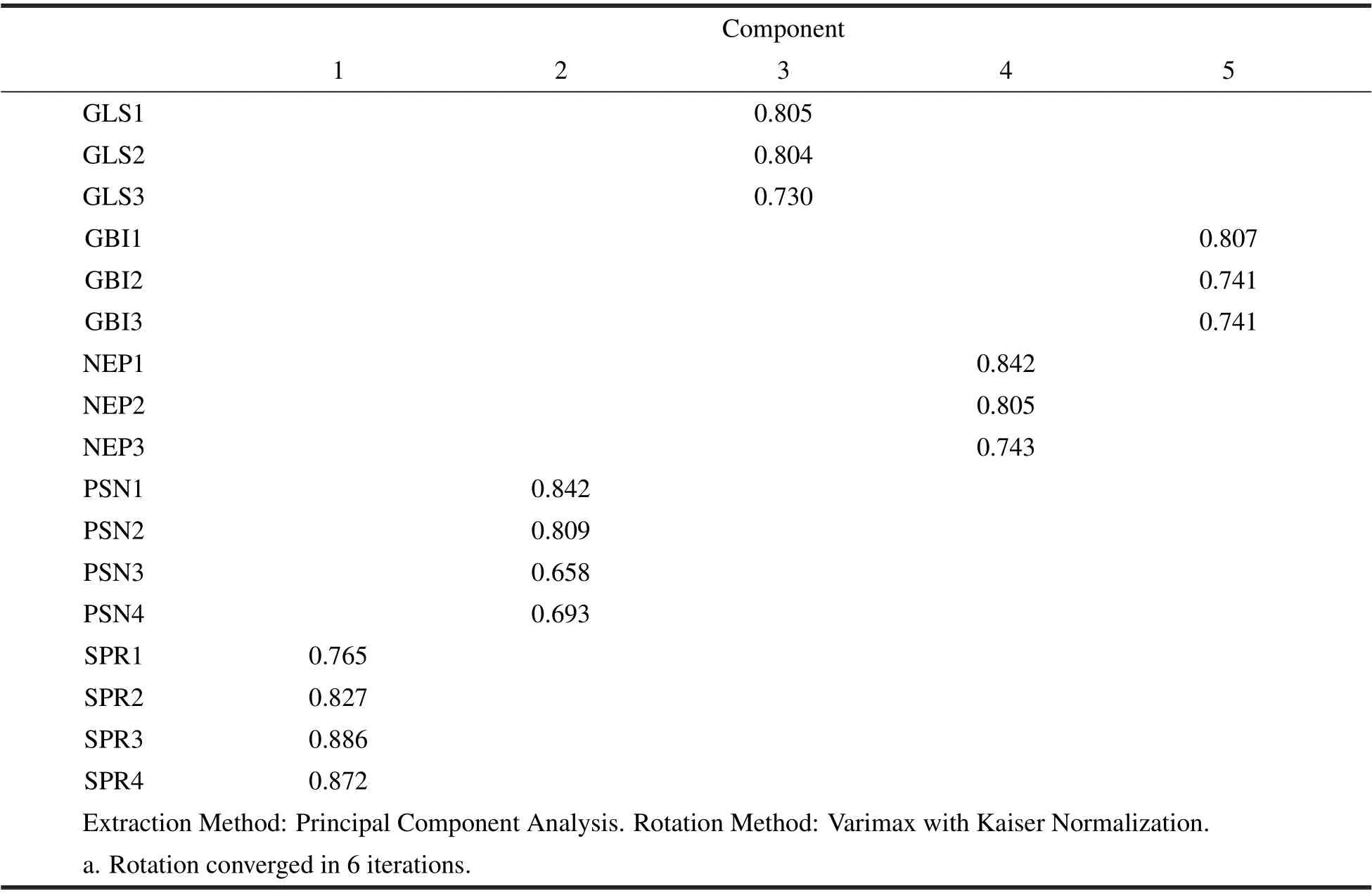
Table 10 Rotated component matrixa.

Table 11 Regression weights.
Table 13 shows that NEP has a positive relationship with Green Behavior Intention at 0.01 statistical significance. Consecutively, Green Behavior Intention has a significant relationship with Green Lifestyle at 0.01 statistical significance. Meanwhile,no significant relationship is found between New Environmental Paradigm and Green Lifestyle. Therefore,we can conclude from the trimmed model that there is a full mediation of Green Behavior Intention in the relationship between New Environmental Paradigm and Green Lifestyle. The two results are consistent with the original model.
Based on Table 14,the trimmed model generates better fit indexes compared with the original model. Overall,the trimmed model has a good fit.

Fig.2 SEM model.

Table 12 Goodness of fit.

Table 13 Regression weights
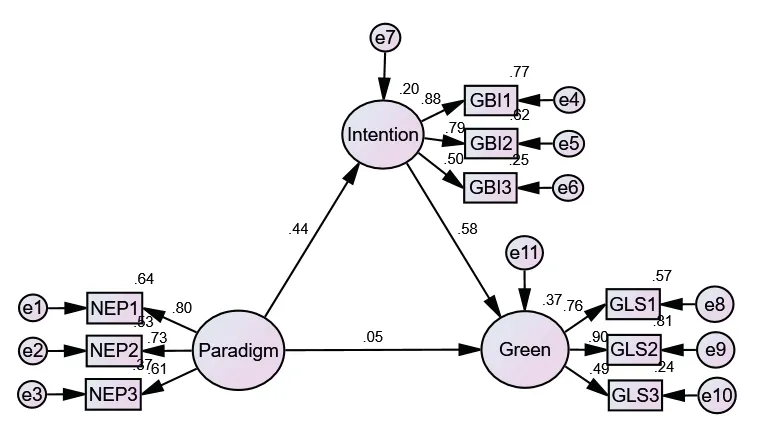
Fig.3 Trimmed model.

Table 14 Goodness of fit Trimmed model
5 Discussions
Based on the findings, we manage to prove that the New Environmental Paradigm (NEP) has a positive and significant effect on Green Behavior Intention(H1). It means that Indonesian millennials who have high environmental concern also have high intention on green consumption. The result supports the findings of Luo and Deng(2008),Hartmann and Apaolaza-Ib´a~nez(2012)and Shukla(2019).
We manage to prove that Green Behavior Intention has a positive and significant influence on Green Lifestyle(H2). It means that Indonesian millennials who have high green behavior intentions are more inclined towards green lifestyle. The result supports the findings of Nguyen et al. (2019)and Yuriev et al. (2020).
The direct relationship between NEP and Green Lifestyle(H3)cannot be supported in this study. We found that there is a full mediation of Green Behavior Intention in the relationship between NEP and Green Lifestyle.In other words, the NEP influence on Green Lifestyle is indirect. In general, this is in line with the Theory of Planned Behavior(TPB)that the effect of attitude on behavior is indirect and is mediated by intention(Ajzen,1991).
Our study cannot support the relationship between Religious Passion and Green Behavior Intention (H4)and the relationship between Spirituality and Green Behavior Intention(H5). The results support the finding of Hassan(2014)that religious values are not a significant predictor of green purchase intention. A study by Wang et al. (2020)also reveals that extrinsic religiosity(religion as a tool for self-serving and non-religious motives)does not influence pro-environmental behavioral intention.
We manage to prove that Religious Passion has a positive and significant effect on Green Lifestyle(H6). It means that Indonesian millennials who are strongly passionate about their religions are more inclined towards green lifestyle. The result supports the works of Arli and Tjiptono(2017),Muhamad et al. (2019)and Taylor et al. (2020).
We partially prove the relationship between Spirituality and Green Lifestyle(H7). Although the relationship is significant,the nature of the relationship is negative. This result supports the argument of Taylor et al. (2020)that adherents of monotheistic religions can be“deeply anthropocentric with their assumption that human beings have superior spiritual and moral value,and special earthly authority”(p.42)hence are less likely to engage in pro-environmental behavior. Since all our respondents in this study are all adherents of monotheistic religions(e.g. Islam,Christianity),we argue that believing in one’s superior spiritual value explains the negative effect.Future studies should investigate more deeply on the specific domains of spirituality that distance a spiritual person from green lifestyle.
The theoretical contributions of this study are as follows: first, this study reveals some of the antecedents of green lifestyle among millennials. Green lifestyle is not limited to consumption of green products but also one’s participation in green events. This study enhances our understanding of the formation of green lifestyle,especially among millennials. Second,this study provides empirical evidence on the less investigated relationships, such as between religious passion and spirituality on green lifestyle. This study reveals that religious passion(religiosity)and spirituality are two distinct constructs that influence green life style in different ways.Future studies can incorporate other elements of culture, such as ethnocentrism and collectivism, especially when dealing with Indonesian-made green products.
The managerial implications of this study are as follows: first, green marketing campaigns should incorporate themes stemmed from NEP, such as the idea that overpopulation and irresponsible lifestyle may cause ecological catastrophes. We argue that people with negative attitudes towards their environments will seek to fix them through green and sustainable products and productions. The greater the concerns on the negative impacts of one’s activities towards the environment, the greater the green behavior intention. Second, this study calls for an inclusion of environmental education into religious curriculum and teaching so that religion can play a more pivotal role in promoting green behavior. Specifically, we look at the role of educational institutions to support the provision of information about green knowledge and make school policies that promote green lifestyle among their students. Moreover,religious institutions can also contribute in promoting green lifestyle by delivering religious sermons that link environmental protections with religious duties.
This study limits itself to Indonesian millennials who live in Asia and Europe regions. Indonesia is a multiethnic country.It has over 300 ethnic groups(Chairy and Syahrivar,2019);however,this study does not make an‘ethnic’distinction. Future studies may incorporate ethnic distinction in order to see if there are any differences in beliefs and values toward the environment.
6 Conclusion
We conclude that the green behavior intention among Indonesian millennials is motivated by the New Environmental Paradigm(NEP).Meanwhile,green lifestyle among Indonesian millennials is motivated by religious passion and spirituality. In line with the Theory of Planned Behavior(TPB),green behavior intention is a strong predictor of green lifestyle. In general, Indonesians in Asia and Europe are concerned about the limit of the number of people the earth can support,the balance of nature which has been upset and the possibility of major ecological catastrophe due to irresponsible lifestyle. The results of this research indicate that there is no statistical difference on the aforementioned concerns between Indonesian millennials who live in Asia and those who live in Europe. It means that the environmental concerns are widespread among Indonesian millennials wherever they are.Moreover,the results also indicate that regions(where Indonesians currently live)highly influence their green lifestyle. Contrary to the current belief,Indonesian millennials who live in Asia are more committed to buy products that have a lower polluting effect and to switch products for ecological reasons compared with Indonesian millennials who live in Europe. Our explanation is that with unequal development of technology and quality of life between the two regions,Indonesians who live in Asia experience a greater sense of urgency to fix their environments and improve their lifestyles, such as through green consumption. Meanwhile, better quality of life coupled with strong environmental programs in Europe has made Indonesians who live in the region experience less urgency to gravitate towards green lifestyle.
Acknowledgement
This research was funded by President University,Indonesia.
杂志排行
Journal of Environmental Accounting and Management的其它文章
- The Development of Countering Monopolization in the Electric Energy Industry
- The Influence of Alternative Fuels on the Development of Large-Scale Production
- A Retrospective Comparison on Europe and China Ecological Wisdom of Pre-Industrial Urban Communities of under the Lens of Sustainability Pillars
- Legislative Regulation of Criminal Liability for Environmental Crimes
- Regional Diversif cation of Rural Territories with Limited Spatial Location of Green Tourism Objects
- Influence of Intensity of Rain Strains and Slopes on the Development of Soil Erosion under the Forest
